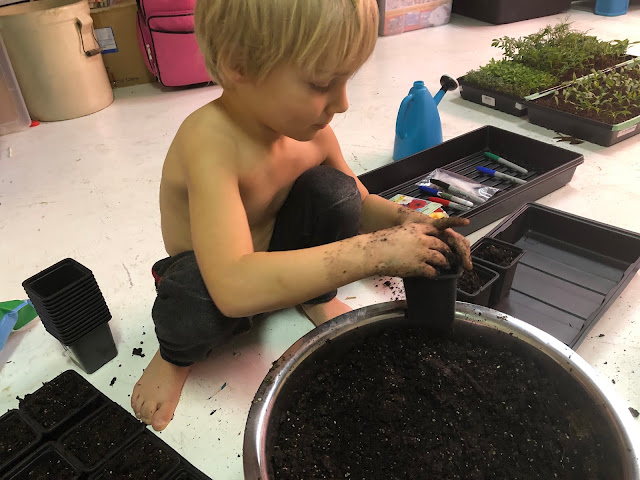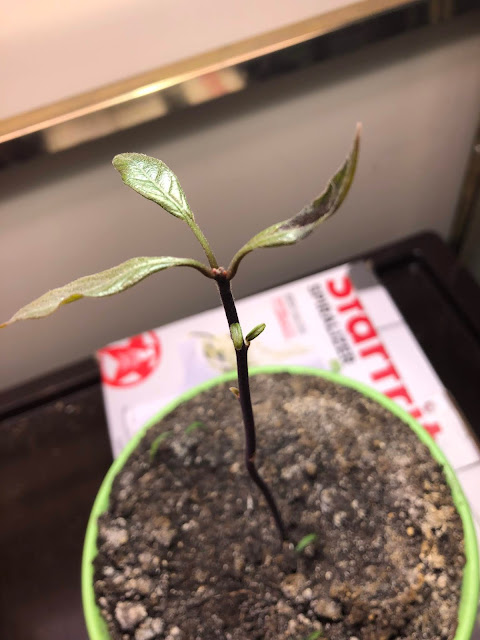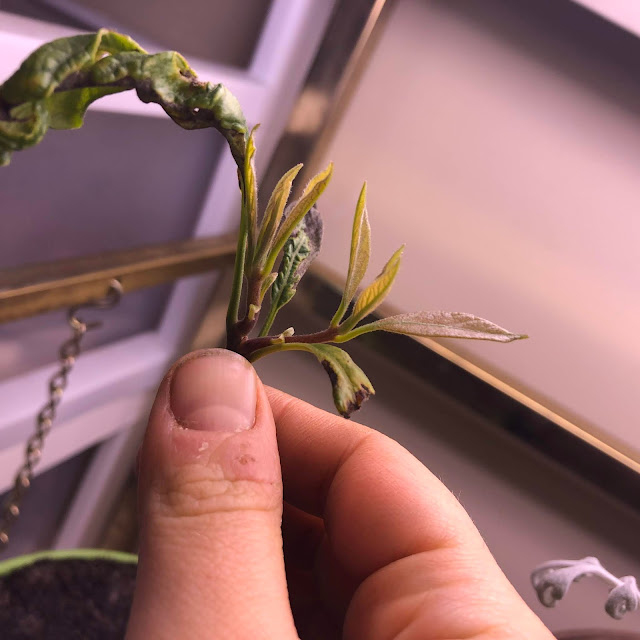Lets talk about Perennials! This post is gonna be from the bare-bones-basics, information for any of you who may not understand the world of perennials! So if you're a more experienced gardener, this may be a bit basic for your needs. But who knows! We can all learn something new right!? :)
 |
| onion chives are a wonderful perennial. Did you know that they flower? yup! they are very pretty as cut flowers! |
WHAT'S A PERENNIAL?!
Have you ever noticed that some flowers and plants need to be planted every year, and some come back year-after-year? Well, that's what I'm talking about! :) A Parennial is a plant that you plant one year, and then it comes back the following year, and potentially for several years after that!
 |
| hydrengia's are a perennial that take a few years to establish. But their floral show is worth the wait! |
Similar to Perennials, there are also flowers whose seeds survive our winters and new plants spring up the following year. Technically this is NOT a perennial, but a zone 3 annual. Forget-me-knots, dill, sweetpeas, marigolds, clover, even those darn cherry tomatoes that spring up from fallen fruit last year. These are not technically perennials, because it is a new plant that grows each year. Perennials, use the same root system from the previous year.
 |
| people often mistake forget-me-not's as a perennial. In reality they simply let down many seeds every year and the seeds sprout in early spring. |
Have you ever heard someone talk about an apple tree, comment about how poor the production of fruit was this year, or vice versa, how well it did? some perennials are actually classified as BIENNIALS. This means they produce flowers or fruit every OTHER year. Saskatoon is a biennial. One year you'll have a bumper crop, and the next year, almost nothing at all. Hollyhocks are both a Biennial and a re-seeding plant here in Manitoba. They only produce blooms on the same root stock, on the second year, and then the plant dies, leaving seeds for the following year. So plants like this are good to plant two or three years in a row for a consistent harvest of blooms or fruit. Though once established, plants such as apple trees and Saskatoon will fruit based on the climate as opposed to the year they were planted. If its a wet year, there will be more Saskatoons than a dry year, regardless of when the plant was put in the ground.
 |
| Hollyhock plants in their second season, producing blooms that will be full of seed pods to drop for the following year. |
WHY PERENNIALS?
Planting Perennials has it's appeal to many people:
- For one thing, it's cost-effective. You have the same plant year-after-year and you dont have to buy it over again.
- spring perennials are a wonderful treat! It allows you to have flowers in your yard long before the may-long-weekend planting season begins. These are the bulbs planted in the fall after first frost.
 |
| Tulips and irises are popular fall bulbs to plant that give a wonderful early spring show! |
 |
| Sedum's unique succulent-like foliage in the spring |
 |
| Sedum's wonderful autumn color-changing flower show! |
- For another thing, they are lower maintenance. The first year you grow a perenneal, you still treat it like any other flower in the garden, giving it water, weeding carefully, sheltering it from frost if necessary etc... But after that? Once the plant establishes (sets down it's roots and is here to stay) you have to do absolutely NOTHING for it! The plant has figured out how to survive. It's got deep enough roots that it doesnt require regular watering.It's stronger than most competing weeds in it's space, and it's accustomed to the climate's cool and hot spells.
- Perennials tend to give an air to non-gardeners, that you "really know what you're doing"... In reality, the plant does everything. Technically Annuals (the name for plants that must be planted every year AKA: Annually) are far more work. Needing to have the soil tilled, being watered regularly, weeded, sheltered etc...
 |
| A field of Lupines |
PERENNIAL FOODS?
There are several food items that can be grown as perennials here in Manitoba. A non-exhaustive list includes:
-Apple trees
- sour cherry trees
- blueberries/saskatoons
- strawberries/raspberries
- apricots/plums
- onions/chives
- peppermint
- oregano
- lavender (some years)
- asparagus
 |
| a Perennial mint plant |
 |
| Perennial Oregano plant |
The beauty of growing these things as perennials instead of anuals, is that the plants get larger and tougher to the climate! Something like Oregano that is very slow-growing, makes a wonderful perennial. It sends up shoots from all of it's roots. So in it's second year, the plant will be 4-5 times the size of last year's plant, in early may! :) So if you're a mint fan, get planting!
WHY OUR ZONE MATTERS:
We live in the climate/gardening zone 3B here near winnipeg manitoba. This is a classification given based on how long and cold our winters are, how warm and sunny our summers are etc... This type of classification allows gardeners to understand which plants will grow in their climate.
For example: Did you know That a tomato plant is a perennial? It IS! The plant itself can live for several years in it's proper tropical climate, producing fruit in it's season. It's not a perenneal here though. Because we are zone 3, not zone 8 climate.
 |
| Perennial Tomato plants in a tropical climate. The same plants used year after year for tomato production. |
 |
| Geraniums are an annual here. But in zone's 5-8 they can be planted as a perennial! :) |
HOW TO CHOOSE A ZONE 3 PERENNIAL:
 |
| a pretty weeping Japanese maple... you'll see these in local greenhouses, but when you look at the tag, it's a zone 4 or 5 even. This will not survive our winters. |
HOW TO ESTABLISH A PERENNIAL:
Most of the time there's no magical tricks to growing a perennial. You plant it in the spring, water it and tend it, and when winter comes, you simply pray it'll come back next year! One trick that can help, is to not water it quite as often as your annuals. When a plant is dry (not crispy and wilty, but just dry), the roots grow deeper, in search of more water. As a result, your perennial's roots will establish farther down in the soil, giving it a better chance of surviving the winter.
For trees, you can even buy an attachment for your hose that is a post with holes in it. you pierce it deep down in the soil, and water the tree's roots BELOW the root ball to encourage the roots to grow downwards to ground water, not upwards toward surface water.
You can also research individual perennials, to find out if giving them a spring or fall fertilization will help them out! And if you're really concerned and want to keep it, after the first frost, simply mulch the tender perennial plant with wood chips, or dry leaves or burlap. That way, if the snow coverage is poor (like this winter was) your plant has some extra insulation!
DON'T GET DISCOURAGED!
If you do some research into Perennials, you'll notice we're actually in a very cold zone, and don't have that much variety in our perennials. But climate changes over time, and so do gardening techniques. The variety of perennials we have today is vastly larger than it was even 10 years ago! People are grafting branches of tender plants onto hardier plants (such as putting the branches of a BC apple tree onto a Manitoba crab-apple trunk) so we can have wonderful varieties here too, that are strong enough to survive our winters!
 |
| Rhubarb |
And I look forward to seeing how the varieties continue!
GROWING A PERENNIAL GARDEN:
It takes many years to establish a fully perennial garden. Each plant will grow best in a specific location in your "micro-climate" (the term used to describe how your back yard grows, compared to someone else nearby). You might move a plant around several times before you find it's sweet-spot. And then, you'll want to take into account when a plant flowers! You may have beautiful plants, but if they all flower early spring, you'll be bored the rest of the summer with your garden. It's best to spend a year or two taking note of OTHER people's gardens, asking questions, making notes of flowers you see in fall and late summer that are perennial etc... Similarely, if your garden area is shaded, to walk around and do some eye-to-ground research on what does well!
The easiest way to start a perennial garden is to do 80% annuals, 20% perennials the first year. Then year after year, see what comes back. Slowly add a perennial here and there, and phase out the annuals. But allowing room for this to take time, allows you to have beautiful flowers all summer long until your perennial garden is fully established. And when that happens, you won't be sorry you invested the time in creating it! :)
That's all for this week's lessons. I hope I was able to bring a new tid-bit to your green thumbs! And I hope i've also removed some of the hype about perennials that scares new gardeners away from them. Try them out and see what happens! :)
Until next time, keep things green!























































